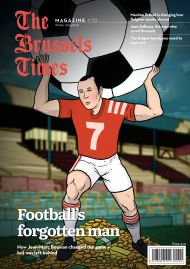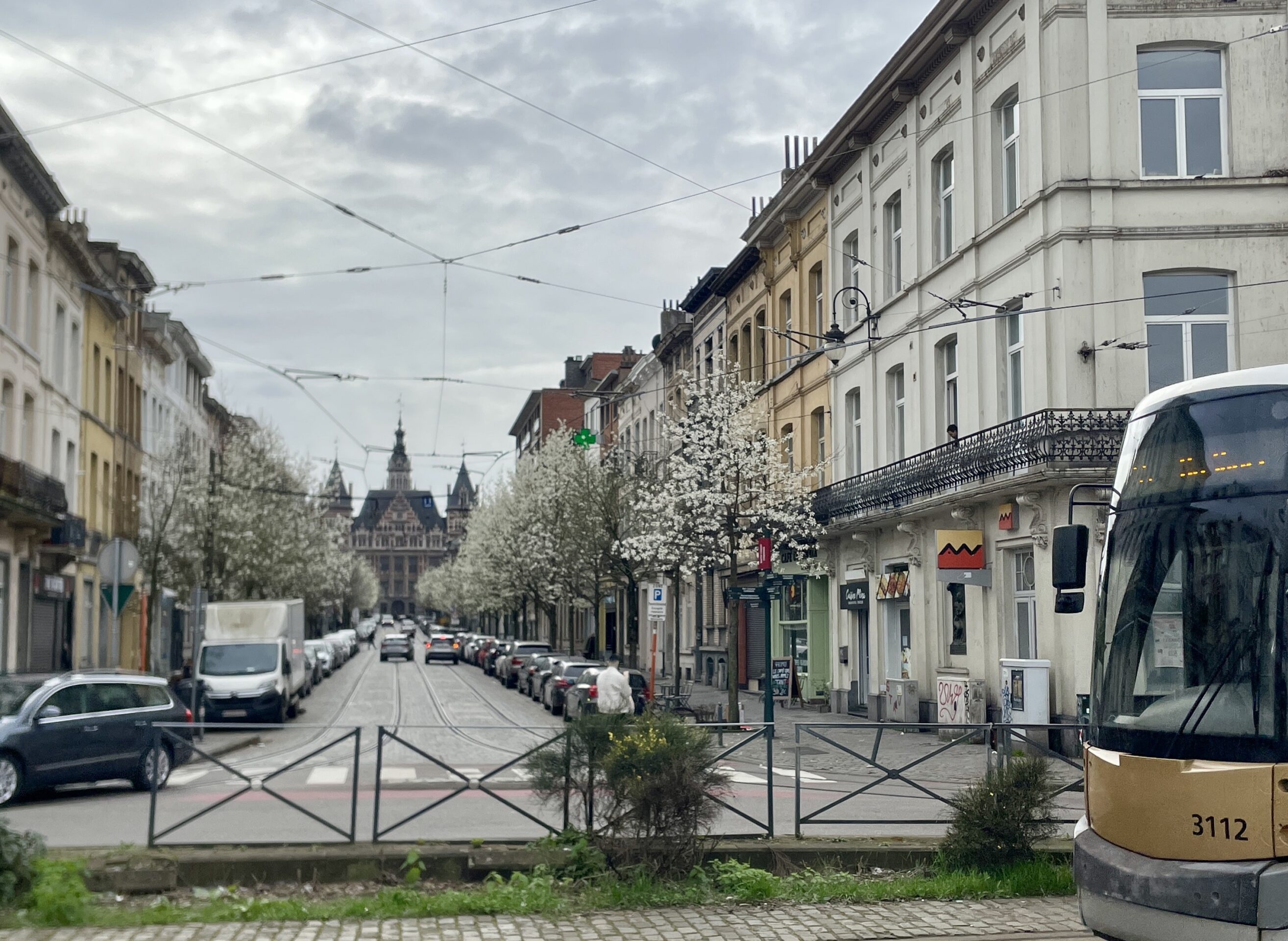Tram 55 awaits its journey snuggly berthed under the Place Rogier/Rogierplein metro station (Rogier). It welcomes passengers at the buffers sandwiched above by the east-west metro and below by the north-south pre-metro trams. The square at ground level is elegant enough at last after what seems like half a century of municipal dickering.
Rogier, as it is called by most, boasts several buildings of some nobility. On its north side was, originally, the rather elegant Brussels-North station. One does not normally think of large railway stations as skittish but in 1952 the station upped and moved several hundred yards further north.
This unexpected déménagement was to accommodate the underground tunnel linking it to Central and South stations. It was replaced by the unloved Martini Centre which in its turn was replaced by the Rogier Tower. It is 136 metres high and is one of the few skyscrapers in Belgium which does not have a horizontal roof. And is one of the few in the world whose roof is made entirely of glass. It has an elegant system of LED primary colour lighting which permits dramatic displays for festivals of varying degrees of solemnity such as Red Nose Day, Gay Pride and national holidays.
On the square’s eastern side is a brace of hotels side-by-side which encapsulate two of the great architectural movements of the early 20th century. The Hilton, originally called Le Palace, from 1909, is a classic Art Nouveau building; think Klimt and you’re already there. At its side is the more industrial, more austere Art Deco Hotel Indigo.
Should you seek solitude in this busy part of town tack 180º around the hotels and retire to the nearby Botanical Gardens which are a haven and a delight. They make an agreeable shortcut from Porte de Schaerbeek/Schaarbeekseporte down to Rogier and an excellent place for shoppers or commuters to eat a midday sandwich.
In the middle of the square is a 64-metre diameter see-through awning which acts as a massive umbrella. A discrete act of architectural genius permits the literally benighted metro passenger to enjoy a clear view via the upward staircase of the Rogier metro station, through the massive awning to the blue, or more probably grey, skies above.
Belgium’s Washington
The eponymous gentleman after whom the square is named merits some attention. Charles Rogier, initially a journalist, led a doughty campaign against the Dutch occupation in the 1820s despite being of French origin (his father perished in Napoleon’s horrific retreat from Moscow, which may have influenced his feelings on invading armies).
As the 1830 insurrection turned into a full-blown revolution, Rogier arrived from Liège with 300 minutemen and joined in the fray. He prevented the Dutch from destroying the Brussels Town Hall and was later dispatched to Wallonia to put down a miners’ counter-insurrection.
Washington-like, he morphed from war-like soldier to (relatively) peaceful politician. His workload in the early days of the new-born Belgian state was breathtaking. He was prime minister twice; he fought for a constitutional monarchy and succeeded, albeit not with the king he wanted; was governor of Antwerp under tricky circumstances (the Dutch still occupied the citadel there); fought a duel in defence of his good friend Paul Delvaux; and was instrumental in setting up the national education system.
Most importantly he was also the prime mover in founding the Belgian railway network in the teeth of violent opposition. He feared that the Dutch might shut down the port of Antwerp and the new nation’s national economy would be stillborn. Efficient national and international freight was essential. One can almost hear him mutter down the ages “Must I do everything?”
Belgium was very much an early adopter of railways on the continent. It built its first tiny passenger railway station a short walk from what is now Brussels North Station (Gare du Nord/Nordstation) and the 55’s first stop. Not only Belgium’s but continental Europe’s, very first railway station, Gare Allée Verte/Groendreefstation, once stood by the canal where the small Maximilian Park is now. In the park, sadly, I can see no memento of its illustrious history.
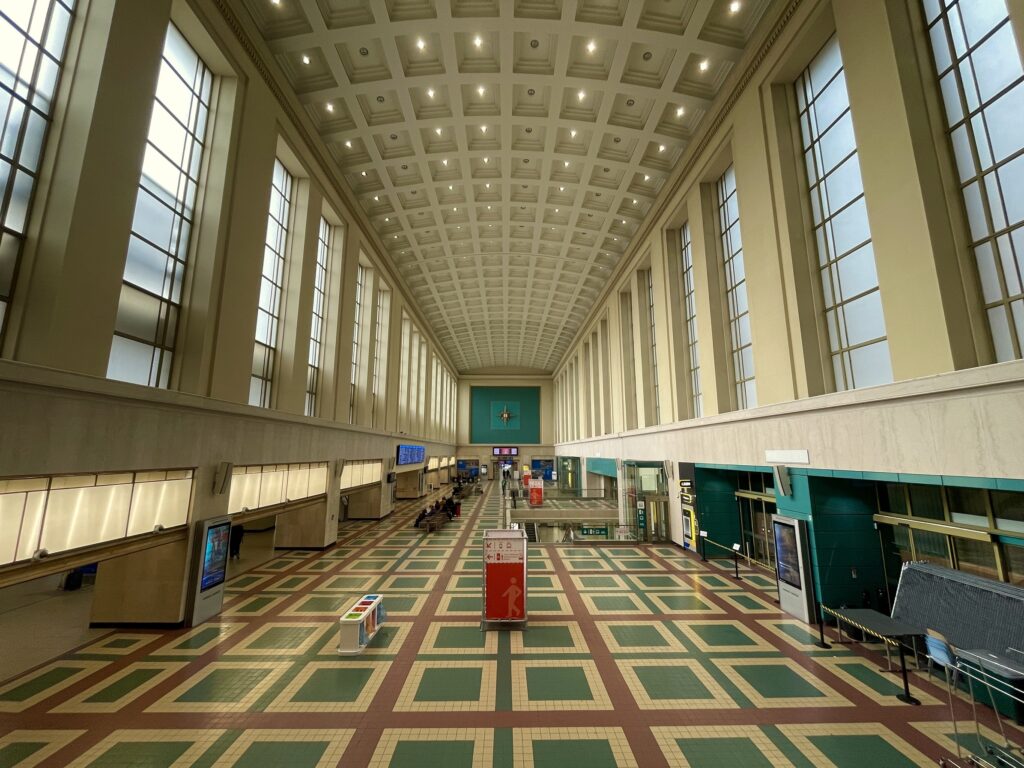
Gare du Nord
Here the Brussels–Mechelen line was inaugurated with great ceremony in 1834. Over 150,000 Brusselaers would travel to Mechelen in the first month just for the fun of it and there were stories of disorder and police intervention when the wooden ticket office just couldn’t cope! The North Station’s migration resulted in Allée Verte’s unsentimental closure. During the Brussels World’s Fair in 1958, the space was used as a helipad to whisk the great and the good out to the jollifications.
The main concourse and the ticket offices of the railway station are light and airy, the clock tower and outer building elegant, the shopping area perhaps a little dark, and the main exit gives out onto an area of high-rise offices stretching west to the canal. I read that this is sometimes called Little Manhattan although I confess in half a century in this town, I have never heard it called any such thing.
The proximity of the offices means that the traffic is predominantly commuters. Brussels lies at the epicentre of one of the busiest railway networks in the world and this station handles about 200,000 people a day morning and evening during the week.
A cartoon in a long-ago New Yorker showed an inoffensive businessman descending into the city subway. As he went down in frame two, he had a forked tail, then frame three cloven hooves, and finally frame four horns on his forehead and a demonic grin as he arrives at the platform. I always feel a bit like him when I descend from the railway station some 60 metres past the huge bus depot and down to the Stygian depths where the 55 glides in.
Street of ill reput
The tram continues its journey and emerges blinking into the sunlight. It follows the railway embankment on the right until it swings east under a railway bridge where it stops briefly (Thomas). There are two good reasons not to alight here. The tunnel is dark, litter-strewn and malodorous. And the nearest street is the infamous Rue Aerschot/Aarschotstraat.
Just like Amsterdam, Brussels has its girl-in-the-window district. In Brussels, it is confined to the street running parallel to the railway lines to the north-east of the station. Although the spectacle is unedifying and raises troubling questions about trafficking, the street is safe enough for passers-by in the daytime; not least because the eastern entrance to the station platforms pours commuters into and out of it.
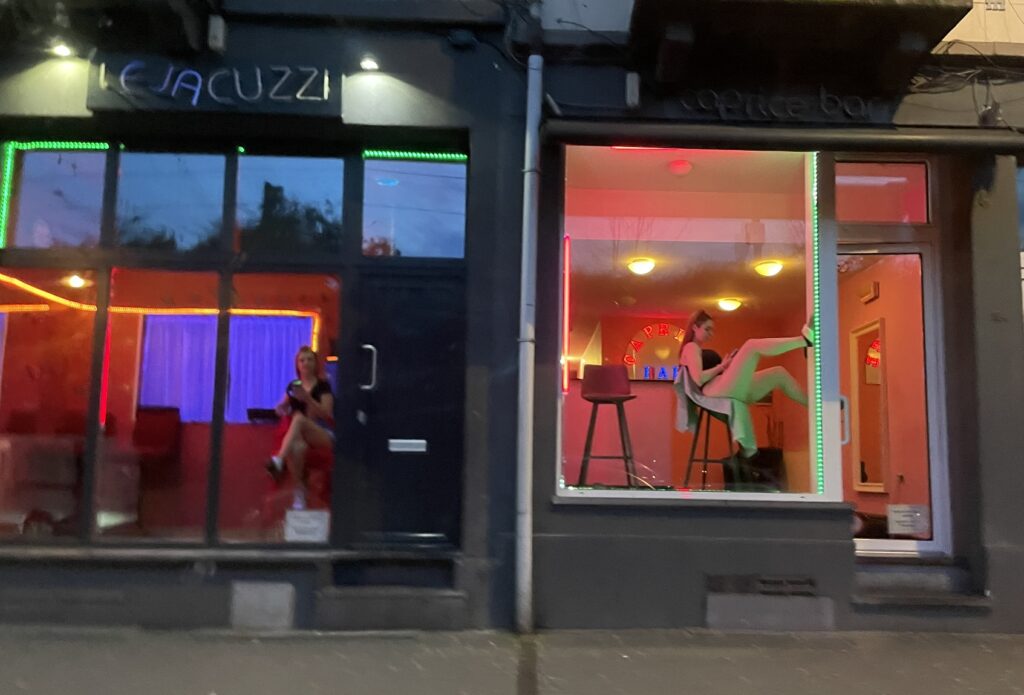
Rue d'Aerschot
The practice of restricting the low end of the sex trade to a small area is defended by sociologists, lawyers and police on the grounds that you can’t get rid of prostitution and driving it underground has other, far greater, risks. If, on the other hand, you box the cheaper end of the trade into one place it is easier to police. And, let’s be honest, you protect the rest of us from the concomitant criminality.
Prostitution is legal and taxable in Belgium but soliciting and keeping a house of ill repute is not. So limited is the area that that part of the street, consisting of cheap but respectable rented flats, has reverted its name to the original pre-World War One Rue de Cologne/Kolnstraat. Long ago anti-German sentiment can now be safely ignored.
Better by far to continue to the next stop (Liedts) and take a relaxed wander down the heady delights of Rue Brabantstraat to your right. You don’t have too much choice about your pace, at least at peak hours. You must move with the crowd. Then feast your eyes.
Shops, with a strong Middle Eastern slant, sell pretty much everything under the sun: Egyptian CDs (yes, really) by stars with bedroomy eyes, footwear from crocodile skin winkle-pickers to army boots and those leather sandals worn by hardy Moroccan men throughout our shivery winter, shiny Arab wedding dresses of every conceivable colour and for every conceivable size and shape, hardware stores with more aluminium ladders than can reasonably be expected in this universe, wallpaper, spices, dried fruit, suitings for men who like their suitings sharp, those hooded coats called djellabas, and, oh, pretty much anything.
Several of the restaurants, fritures with cumin and coriander flavourings, have barkers outside when business is slow. Do not be afraid to engage with them. They are universally polite rather than aggressive. Having joshed with one I regretfully declined and he said to me, “Well, think about us next time you’re down this way.”
Then he patted his chest in the Muslim sign for sincerity. And the portions are heart-stoppingly humungous, with chips cascading out of their cardboard containers onto the plastic tray beneath. Eat the fallen first; they get colder quicker. When I lived in Schaerbeek this vibrant street was part of my weekly walk home from a teaching gig. Always a pleasure.
La Cage aux Ours
The tram then slips along the slightly, one might almost say charmingly, grungy Rue Gallaitstraat; offering as it does the occasional glimpse of Schaerbeek’s magnificent neo-Flemish Renaissance town hall (Pavillon/Paviljoen). If you choose to alight, you would be free to wander in and inspect one of the wonders of late-19th century municipal architecture.
The central hall is beyond filmic and would serve any director not overly burdened with a sense of historical accuracy for, say, Ellis Island, a Victorian London police station, Paris’s Town Hall, or maybe the meeting chamber of the Galactic Supreme Council. Extras would be available aplenty among the patient populace awaiting processing. The surrounding square, Place Collingnonplein, is being fitfully gentrified. Lattes are served by boys with man buns and long aprons right next to venerable paint shops and working-class beer joints.
If you have never heard of Place Eugene Verbroekhoevenplein (Verbroekhoeven) you are in good company. While officialdom stick to the, well, official name it is universally referred to by us plebs as La Cage aux Ours (The Bear Cage). I have never heard this massive - nine ingresses and egresses at the last count – roundabout called anything else. It is something of a social centre with greenery and park benches. But there was never a bear cage there. Its nickname hailed from an unseemly municipal stooshie long, long ago.

La cage aux ours
In 1878, the Catholic mayor of Schaerbeek, Guillaume Dennis, had spruced up the roundabout with pebbles and iron fencing. His anticlerical nemesis on the council, one Henri Bergé, poured scorn upon the mayor’s pride and joy and compared it to the bear garden in Bern which he had recently visited. It stuck!
Just 100 metres back from the next tram stop (Waelhem) at 62 rue Waelhemstraat, is a small English theatre called The Warehouse. There are some supremely active amateur clubs in town. Shows can be of a professional standard and there is something on most months of the year (full disclosure: I have been acting and directing in English in Brussels for many decades).
There are clubs dedicated to musicals, American, Irish and British theatre, Shakespeare and his contemporaries, and European drama. If you want to see what’s on go to theatreinbrussels.com. Musicals, Shakespearean productions and pantos, having large casts, tend to take place in bigger venues around town; but more intimate productions suit the 60-seat Warehouse. Parking is nigh on impossible, so the 55 and 7 trams are your friends. The area is not dangerous, the neighbourhood car workshops stay open late, but it is a little shadowy after dark. Best to go accompanied if you’re nervous.
There’s another theatre, run by Evere commune, a little further up the road (Fonson) called Espace Toots, presumably after Belgian ace mouth-organist ‘Toots’ Thielemans. It runs a fantastic range of events mostly in French. I have always thought it absurd that Brussels is split into 19 communes and then I look at this kind of proud localism and I think again.
The oldest church?
The tram wanders through the Helmet shopping district. Here, 50 years ago, you could still hear the impenetrably rich Brabançonne Flemish spoken by the elderly. Now it is entirely gone. But a reminder of how ancient this part of Brussels is stands nearby in the handsome shape of the 12th century St Vincent’s church. The oldest building in Evere and one of the oldest in Brussels, it stands proudly overlooking the dumbbell-shaped Parc de Bon Pasteur/Goede Heerderpark which lies hard against the railway lines.
Built in local sandstone, between, archaeologists estimate, 1125 and 1255, the church’s first recorded priest was a certain Stephanus who signed on in 1247! The building’s finery was carried away by “Calvinist iconoclasts” in the late 16th century and by 1595 the roof had been completely vandalised leaving worshippers subject to the rigours of the elements.
In 1742 a priest was so incensed at local schoolchildren playing hide-and-seek in the graveyard he had the local school demolished; something of an overreaction surely? Then in the Second World War, German bombs, destined somewhat shakily for Schaerbeek station, fell on its outbuildings. The church is a short walk from the tram route (Van Cutsem); and stands as a quiet, rural contrast to the race-track roads, factories, and blocks of flats that abut it.

Mural near Rue Henri Van Hamme
The 55 reaches its destination (Da Vinci) on the main road out to Zaventem, opposite a massive Decathlon sports store. In 1914, where NATO now stands a little further east, the invading Germans established a military airfield. This became Brussels’ airport for 40 years, saw the set-up of Sabena, the first flight to Kinshasa, a German invasion again in the Second World War, and then a gradual movement of the centre of operations to Melsbroek which in turn morphed into Zaventem airport.
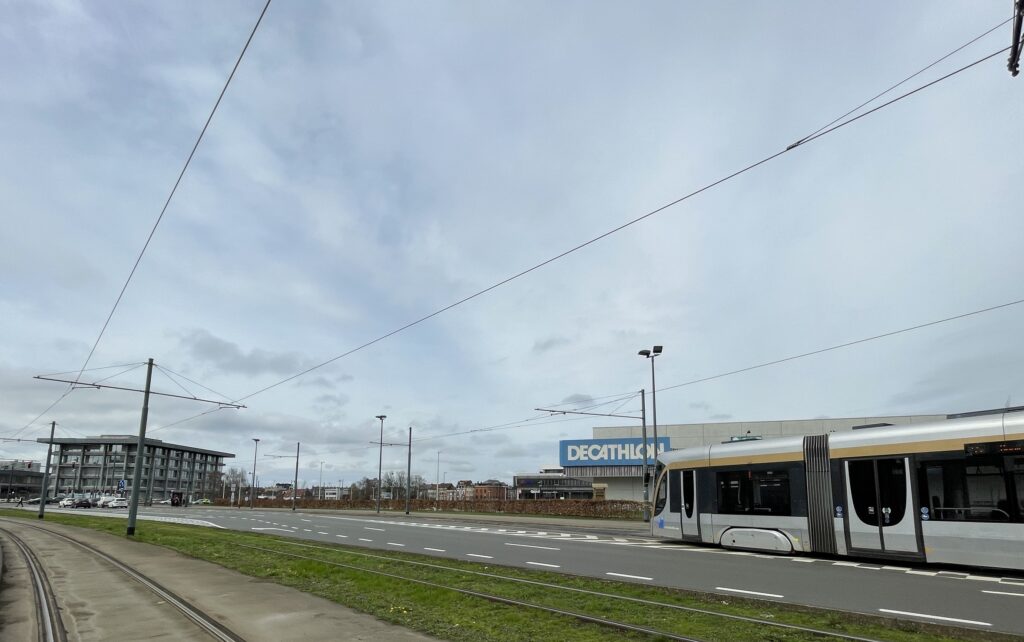
Da Vinci, the terminus in Zaventem
And if you walk along the unlovely and parallel stretch of Chaussée de Helmet/Helmetsesteenweg out of town from the tram terminus, car washes and petrol stations to your left, and a business park with a chain link fence around it to your right, you might think that no trace of Haren Airport remains. But you’d be wrong. There is the elegant headquarters of SABCA, the state-owned aerospace company which earned its spurs here back when biplanes were landing on what is now Boulevard Leopold III. Not only that but if you peer through the fence – the high-security gates do not encourage casual visitors – you will see a few one-story, flat-roofed, industrial brick buildings which can only be described as early-airport brutalist.
If that finally satisfies the curious then one can cross the road and discover, hidden among the ubiquitous gas stations and high-pressure hoses being deftly wielded by the car-proud, a cosy, indeed excellent, little Italian restaurant, Pane e Focaccia, cunningly disguised as a tyre warehouse. This presumably the better to discourage custom. There one can celebrate the end of one’s odyssey with a plate of fettuccine Alfredo and a glass of something toothsome!
